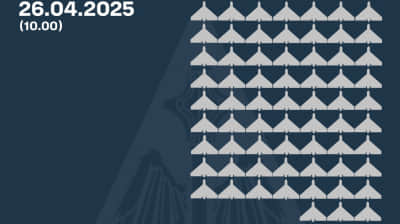Poll reveals fewer Ukrainians willing to bear burden of war for as long as necessary

The number of Ukrainians willing to endure the burden of war for as long as necessary is declining. As of December 2024, 57% expressed this readiness, a decrease of 16 percentage points compared to December 2023 and February 2024.
Source: a survey conducted by the Kyiv International Institute of Sociology (KIIS) in December 2024
Quote from the KIIS: "From the start of the invasion until February 2024, the situation remained relatively stable, with 71-73% consistently expressing readiness to endure the war for as long as necessary (and an additional 2-3% willing to persevere for one year). During this period, 18-21% indicated a shorter safety margin, ranging from a few months to six months. However, between February and October 2024, a notable shift occurred, with the share of those willing to endure for as long as necessary dropping for the first time to 63%.
Between early October and December 2024, a slight but notable decline was observed in the proportion of Ukrainians willing to endure the war for as long as necessary, dropping to 57%."

Details: Sociologists emphasise that the share of Ukrainians who are willing to endure the war for a shorter period (several months to six months) has remained relatively stable, at 21% in December compared to 18% in early October. However, the proportion of those who find it "difficult to say" how much longer they can endure has increased from 12% to 18%.
"Thus, between October and December, there was no decrease in the safety margin among Ukrainians, but rather an increase in uncertainty (reflecting high uncertainty due to a combination of external factors, such as the US elections, and internal circumstances)," the KIIS explained.
Sociologists point out that while the decline in the safety margin between February and early October 2024 was most pronounced in Ukraine's south and especially in the east, by December 2024, regional differences had "levelled off". By the end of the year, the gap between regions became less significant, though the east still had slightly fewer people willing to endure as long as necessary and exhibited higher levels of uncertainty.

Sociologists also examined respondents' answers based on their family income.
"On the one hand, there is a tendency that the wealthier the respondent's family, the higher the safety margin. On the other hand, it is worth emphasising that even among respondents with low incomes (who are, accordingly, quite vulnerable), 51% said they were ready to endure as long as necessary," the survey says.
Among middle-income respondents, this figure rose to 58%, and among high-income respondents, it reached 70%.

"These data show that the willingness to endure war is only partially related to material living conditions and that other factors have a greater impact on the safety margin," KIIS concluded.
The survey was conducted from 2 to 17 December 2024, with 985 respondents aged 18 and over, all residing in the government-controlled territory of Ukraine. Participants were interviewed by telephone through a random sample of mobile numbers.
The sample excluded residents of areas temporarily not under Ukrainian control (although some respondents were internally displaced persons from these territories). The survey did not include citizens who left Ukraine after 24 February 2022.
Under normal circumstances, the statistical error of such a sample (with a probability of 0.95 and taking into account the design effect of 1.3) did not exceed 4.1% for indicators close to 50%, 3.5% for indicators close to 25%, 2.5% for indicators close to 10%, and 1.8% for indicators close to 5%.
During wartime, additional systematic deviations may arise, but sociologists believe the results remain highly representative and reliably reflect public sentiment.
Support UP or become our patron!





